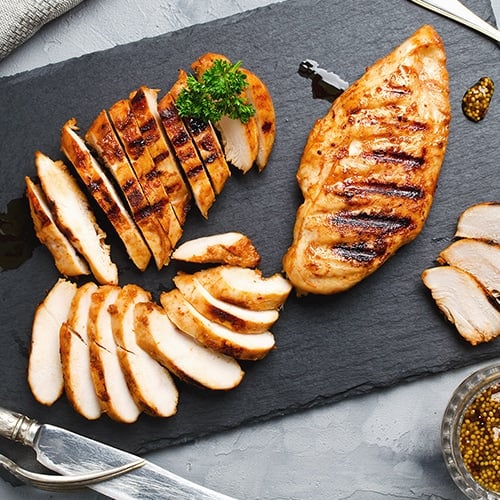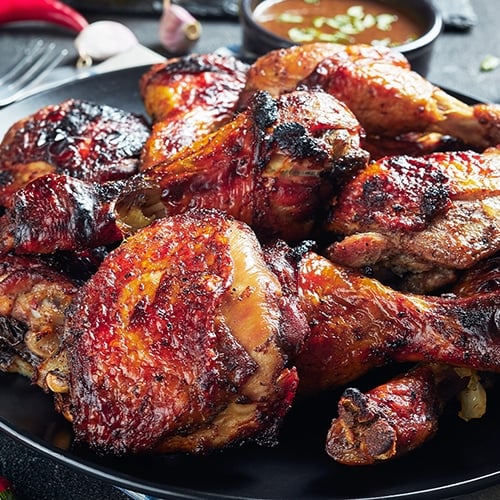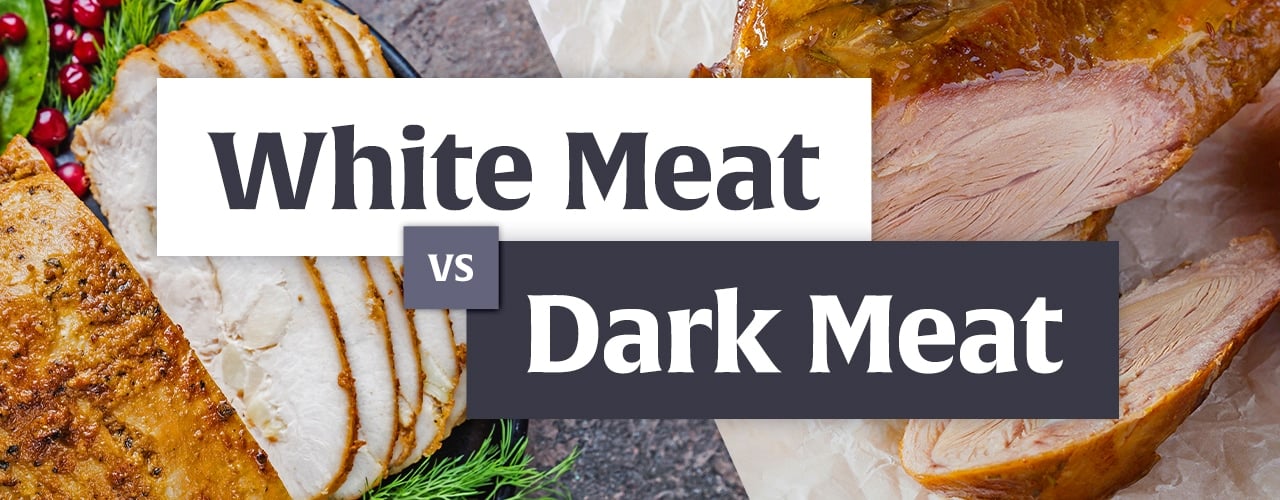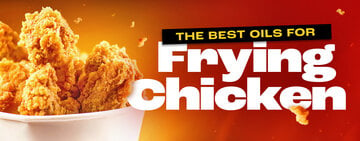Both chefs and civilians debate the benefits of white and dark poultry meat. Whether you prefer the lean and mild taste of white meat or the rich and juicy flavor of dark meat, both are delicious when prepared with the appropriate cooking method for the cut. While some people prefer one over the other, many don’t know what distinguishes the two. Understanding the characteristics of each will help you make the right choice for your culinary needs. We define white and dark meat, explain the benefits of each, and how they compare to each other.
Shop All Chicken and TurkeyShould You Use White Meat or Dark Meat?
Watch this video to decide whether white or dark meat is best for your recipe.
What Is White Meat?

White meat refers to the breast, tenderloin, wing, and parts of the back cuts of poultry meat. These cuts are lighter in color and have a milder flavor compared to their darker counterparts. The meat is white because the muscles are used less frequently and contain less myoglobin, a protein responsible for the red color in meat. Many consider white meat a healthier option than dark meat because it is typically lower in fat and calories and high in protein.
White meat is known for its versatility in the kitchen. Its mild flavor profile allows it to easily absorb marinades, spices, and sauces, making it a blank canvas for a wide range of flavors. While breast meat is prone to drying out when cooked, most white meat is naturally tender because the breast and wing muscles are not heavily worked.
What Part of the Chicken Is White Meat?
The parts of a chicken that are considered white meat are the back, tenderloin, wings, and breast meat. Each part offers a different flavor and texture. We explain the benefits and disadvantages of each cut of white chicken meat below.
- Breast - Chicken breast meat is lean, mild, and high in protein. The con of this leanness is it dries out easily when cooked. It is one of the most expensive chicken cuts.
- Tenderloin - Tenderloin meat is one of the softest and moistest cuts of white meat. It is the cut used to make the beloved chicken tender served at family-friendly restaurants and fast-food chains alike.
- Back - The back cut includes both white meat and dark meat, with the white meat being near the breast. It is primarily used for soup, stock, or broth since there isn’t much meat left on it after butchering the rest of the bird.
- Wings - Chicken wings are one of the juiciest and most flavorful cuts of white meat and they are a perfect candidate for smoking, roasting, grilling, and frying. They are an economical choice compared to breast and thigh meat.
What Is Dark Meat?

Dark meat refers to the meat found in the legs and thighs of poultry. This meat is darker in color compared to its white meat counterpart due to the presence of a protein called myoglobin, which is responsible for delivering oxygen to the muscles and produces the red color in meat. Dark meat is known for its rich, umami flavor. This is because dark meat contains more fat than white meat. The higher fat content also helps to keep the meat moist during cooking, making it less likely to dry out.
While dark meat contains slightly more calories and fat compared to white meat, it also provides higher amounts of certain nutrients. Dark meat is an excellent source of iron, which is essential for oxygen transport, as well as zinc, which plays a crucial role in immune function and wound healing. It also contains more B vitamins, including niacin and vitamin B6, which are important for energy production and brain health.
What Pieces of Chicken Are Dark Meat?
Dark meat typically refers to the pieces of chicken that are found in the leg, drumstick, and thighs. The leg cut of meat includes both the drumstick and thigh. The drumstick is the lower part of the leg, while the thigh is the upper part. While not a common cut, chicken tail meat is dark meat as well. Learn more about the cuts of dark chicken meat below.
- Leg - The perfect cut for a single-person meal, chicken leg meat is rich in protein, omega-3 fatty acids, vitamins, and minerals. It contains both fat and bones, making it extremely flavorful.
- Thigh - Rich in fat, moisture, and flavor, thighs are typically prepared with a marinade to accentuate their natural juiciness. They are an economical choice compared to chicken breasts.
- Drumstick - Drumsticks are an economical choice and beloved finger food. This succulent cut pairs wonderfully with strong seasonings and can be fried, barbecued, or grilled and paired with beer.
- Back - The back cut includes both white meat and dark meat, with the dark meat being near the legs.
- Tail - Fatty chicken tail meat is sometimes served alongside a cut of back, leg, or thigh meat. Some chefs roast or pan-fry it and then serve it as a delicacy, and its high-fat content certainly makes it an indulgent choice.
Difference between White and Dark Meat

Dark meat is fattier and juicier than white meat, but many patrons prefer the mild taste and leanness of white meat. Both white and dark meat come from poultry, but their unique characteristics and benefits make them suitable for different cooking styles and flavor profiles. We’ve provided a list of key differences between white and dark meat below, so you can quickly determine the benefits of each type of meat.
- White meat is more versatile than dark meat. White meat is known for its mild taste and ability to absorb flavors, making it a great canvas for marinades, seasonings, and sauces.
- White meat cooks faster than dark meat. Since it tends to cook faster than dark meat, white meat is a convenient option for busy chefs.
- White meat is leaner than dark meat. Cuts of white meat contain less fat than dark meat, making them a leaner choice for patrons seeking to reduce their fat consumption.
- Dark meat is less expensive than white meat. Since it is less in demand compared to white meat, you can often find cuts of dark meat at lower price points.
- Dark meat is juicer than white meat. The higher fat content and the protein myoglobin keep dark meat moist and succulent. Even in a busy commercial kitchen, it’s hard to mess up a naturally juicy chicken thigh.
- Dark meat is more flavorful than white meat. Dark meat offers a rich, robust, and savory taste. The greater degree of activity in dark meat muscles develops more chemicals, proteins, and fats that create a richer flavor.
White vs Dark Meat FAQ

When chefs start looking at recipes that call for red, white, and dark meat, several questions arise. If all poultry is white meat, how is there dark poultry meat? And if dark meat has so many vitamins and healthy fats, is white meat actually healthier? We address these common questions below.
Red vs White Meat
Red meat comes from mammals and white meat comes from avians (birds). Red meat, such as cuts of beef, pork, and lamb, has higher levels of iron, protein, and zinc than white meat. While cuts of dark poultry meat contain higher concentrations of the protein myoglobin than cuts of white poultry meat, they still contain far less myoglobin than red mammal meat. While all poultry meat is considered white compared to red meat, we categorize different cuts of poultry as either white or dark meat.
Is White Meat Healthier Than Dark Meat?
White meat is often praised for being leaner and lower in calories compared to dark meat. This is because white meat contains less fat, particularly saturated fat, which is known to increase the risk of heart disease. While dark meat is slightly higher in fat content, the majority of this fat is monounsaturated and polyunsaturated fat, which are considered heart-healthy fats. These fats can actually help lower bad cholesterol levels and reduce the risk of heart disease. It's worth noting that the cooking method and preparation play a significant role in the overall healthiness of the meat. Grilling, baking, or roasting poultry without the skin can help reduce the fat content while marinating the meat in herbs and spices can add flavor without adding extra calories.
When it comes to vitamins and minerals, both white meat and dark meat provide a range of essential nutrients. White meat is particularly rich in vitamins B6 and B12, which play a crucial role in brain function and the production of red blood cells. Dark meat, on the other hand, is a good source of iron and zinc, which are important for energy production and immune function. In terms of protein content, both white meat and dark meat are excellent sources. However, white meat generally contains slightly more protein per serving compared to dark meat.
Back to TopBoth white and dark meat have their place in a commercial kitchen. White meat offers a lighter and milder flavor that can be enjoyed in a variety of dishes. From grilled chicken breasts to roasted turkey wings, there's no shortage of delicious ways to savor the goodness of white meat. Whether you prefer the rich flavor, tender texture, or ease of preparation, dark meat certainly has its own appeal. From hearty chicken thighs to succulent turkey legs, this type of meat offers a delicious and satisfying option for any poultry lover.



